“On-demand” says it all, right? It’s a solution learners can turn to when they need it.
And the demand is booming: real-time, need-based tutoring dominated the global market in 2024, generating more than 76% of total revenue.
What’s more, the entire online tutoring industry is projected to grow at an impressive 18.5% by 2030.
But how is an on-demand tutor app different from a Learning Management System (LMS) or a tutor marketplace, which provide guidance for learners as well? Simply put: on-demand apps give immediate help with specific problems, while LMS and marketplaces focus on planned and structured learning.
But understanding these differences is just the beginning. Once you’ve decided that an online tutor app is what you want to build, other questions come to the forefront:
- How complex should the solution be?
- What features does it need?
- What business model will sustain growth?
AnyforSoft has been in the educational domain for over 14 years. We’ve led projects for major educational institutions such as Wittenborg University of Applied Sciences (WUAS) and Imperial College Business School, and successfully expanded the functionality of SaaS companies in the education sector.
Our expertise is at your service to help you answer the most pressing questions, move forward through the development process with confidence, and avoid costly missteps.
What Is an On-Demand Tutor App?
The application we discuss in this article enables learners to book an online one-to-one session with a tutor exactly when they need it most.
What does that look like in real life?
Here are a few common scenarios that show how a tutor booking app works:
- A student stuck on a geometry proof clicks “Get help now” and connects with a tutor within 10 minutes.
- A parent books a same-day homework review for a child struggling with a science assignment.
- A user gets instant essay feedback to polish a draft just before submission.
- A high schooler schedules a last-minute SAT math booster the night before a mock test.
- A learner uses AI-based matching to find tutors available for a quick clarification during late-night study.
Online tutor apps are lightweight, fast, and focused platforms that offer smooth user registration, smart matching, and video conferencing capabilities for real-time, interactive teaching.
This streamlined format reflects what users actually want.
65% of students prefer one-on-one online tutoring over group sessions, which ensures highly personalized support.
However, the way platforms deliver this personalized support can vary significantly, depending on their core goals.
The examples can be spread out on a plane divided by two axes:
- Structured learning vs. particular task solving. Does the platform support long-term learning paths or serve students who need immediate help with a specific problem?
- Self-sufficient vs. requiring integrations. Is the platform built to work independently, or does it rely on integrations with external systems like LMS or Student Information Systems (SIS)?

It may seem that some solutions don’t resemble a classic on-demand tutor app that operates independently and doesn’t involve ongoing communication between a user and a tutor. And that’s true!
The opportunity landscape adapts to user needs, allowing you to develop a solution with extended functionality and custom features.
- You can connect an on-demand tutor app to an LMS, as Paper or Pear Deck Tutor (formerly TutorMe) does, and your solution becomes part of a robust, formal education platform.
- Focus on test preparation capabilities, and you’ll have a platform like Revolution Prep, tailored for SAT, ACT, and other exams, supported by an extended course library that resembles a full-fledged LMS.
The AnyforSoft team is experienced in e-learning web development and complex education platforms integrations where each part of the ecosystem enhances and amplifies the others.
Just one example: for a large education client, we fully modernized their LMS, redesigned the UI from scratch for seamless mobile and desktop use, and built a new admin section for efficient content and user management.
We also enabled support for diverse content formats, including video lessons, interactive quizzes, and fill-in-the-gap exercises — all crafted to deliver a more engaging, scalable learning experience.
Creating an On-Demand Tutor App vs. Building a Marketplace, LMS, or Coaching Platform
You might wonder:
- If an organization already has an LMS like Moodle or Google Classroom, why not just use it? While these platforms support educational content delivery, communication, and even live sessions, they lack the real-time tutor discovery and instant scheduling that define true tutor booking apps.
- Maybe a teaching marketplace like Preply or Wyzant? Though marketplaces let learners reach out to on-demand tutors and schedule lessons, they don’t provide on-the-spot help during the learning process.
Let’s compare the core features of E-learning platforms to see the tutor app’s peculiarities and advantages. On the radar charts below, each “arm” represents one core capability, from booking sessions to compliance. The bigger the “arm,” the more developed that particular capability is within the platform.
Each platforms’ capability is scored using a 5-point scale, from “not supported” to “strong, comprehensive feature.”How to read a chart? Just follow the blue areas to see where the on-demand tutor applications excel.
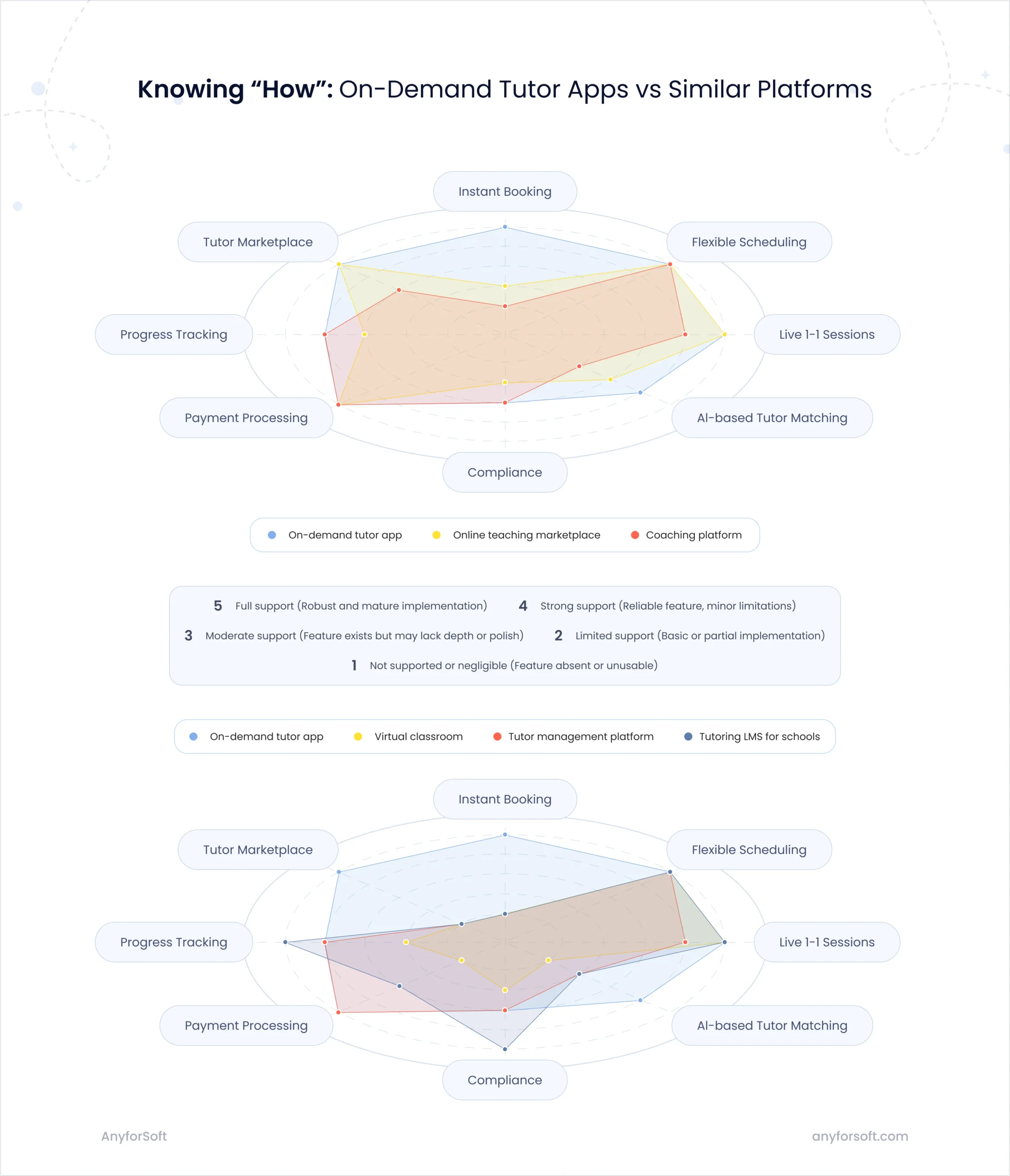
As the radar charts show, on-demand tutoring apps consistently outperform other platforms in areas like real-time booking, flexible scheduling, and AI-based tutor matching. It makes them an ideal choice for learners who need fast, personalized academic support without long-term commitments.
B2C or B2B2C? Defining the Right Business Model
Before jumping into features and tech specs, one question shapes everything:
Who will pay for your app, and who will use it?
Your choice of business model defines your revenue strategy, compliance needs, and your marketing approach.
In online tutor apps, two main paths stand out.
B2C: Direct to learners
A B2C model focuses on individual students or parents.
- Strengths: Fast go-to-market, easier to test demand, flexible monetization (pay-per-session, subscriptions, credits).
- Challenges: Requires a strong brand and continuous marketing investment; user churn can be high.
Cost note: B2C apps like Tutor.com can be more affordable to launch, with lower upfront costs of developing a tutor booking app. However, they depend heavily on constant user acquisition, marketing spend, and scaling volume fast.
B2B2C: Partnering with institutions
A B2B2C model sells your app to schools, districts, or education-focused organizations. These partners then provide access to students.
- Strengths: Stable revenue via contracts, lower churn, larger user bases.
- Challenges: Longer sales cycles, higher compliance standards, integrations with institutional systems (SIS, LMS), and a need for robust admin panels, user management, and secure authentication.
Cost note: B2B2C platforms such as Paper require more upfront investment due to institutional integrations, compliance needs, and administrative complexity. But these investments unlock more stable revenue and longer contracts.
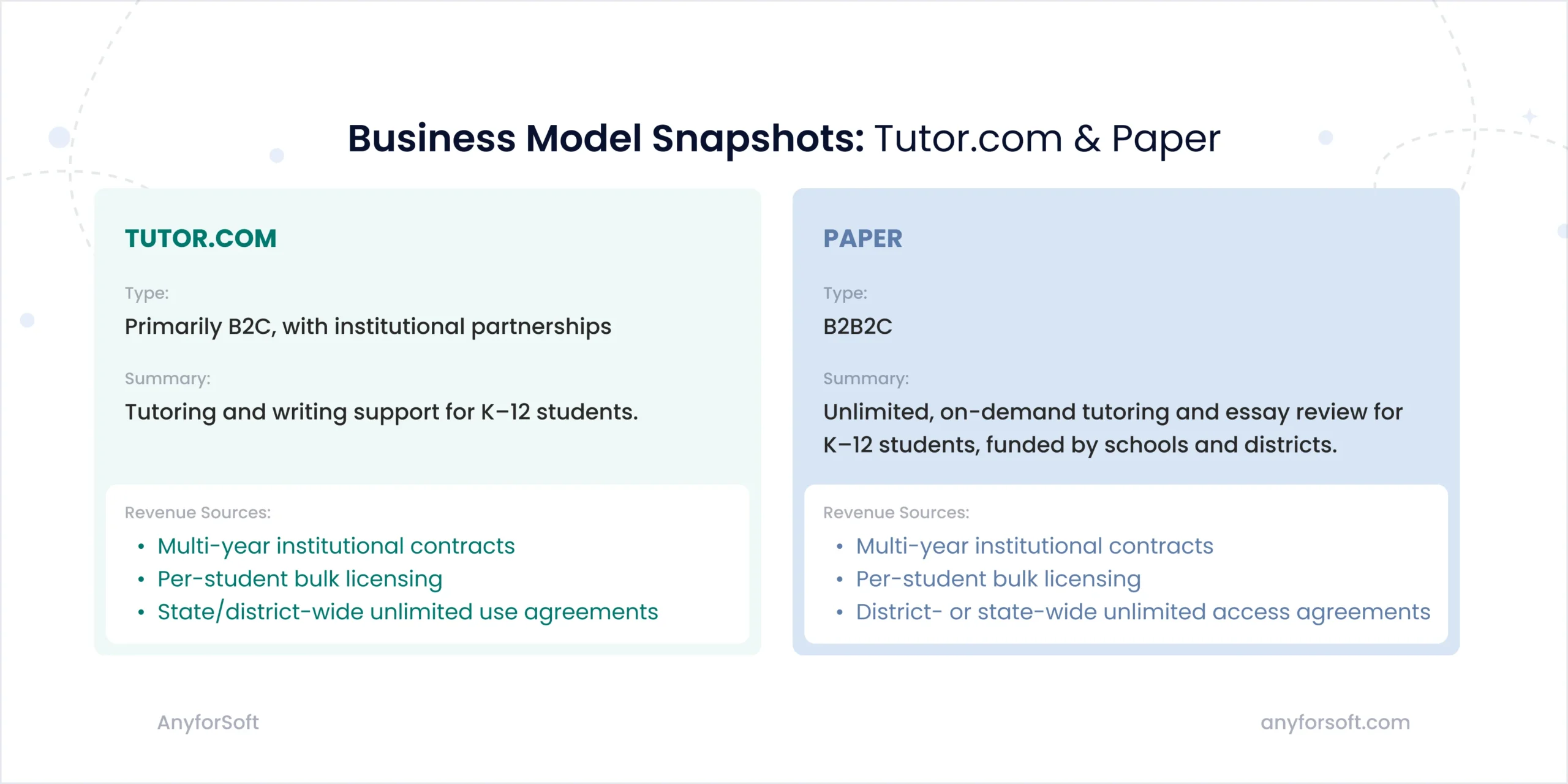
From MVP to Full Platform With a Business Model in Sight
Business model isn’t the only dimension to consider when defining your place on the map of opportunities. Another critical factor is platform complexity and scope of work. This is where the AnyforSoft GOAL Quadrant comes in.
The AnyforSoft team designed this approach to help you find the starting point of your online education platform roadmap.
While this preparatory work isn’t required, it can be incredibly helpful. Consider it as a self-assessment you can use to find answers to the following questions:
- Who’s your target customer, individuals or institutions?
- What’s your launch strategy — to test quickly or build comprehensively?
- What’s your project’s possible scope and budget?
With a Quadrant, you can transform your intention from the general “I have an idea of a mobile application for on-the-spot tutoring” to more concrete “I need a Quadrant X solution.” Whether you address an app development company now, or you’ll need to step back and think, the tool will come in handy to focus your approach.
Quadrant 1: MVP for B2C
This approach is all about launching fast with just enough features to engage individual users and start learning from the market.
Instead of building a full platform, you focus on what helps real students right now: matching, booking, and learning in real time. It’s a targeted online learning app, designed to grow with user feedback.
What to pay attention to:
- User acquisition strategy: Since there are no institutions to onboard users for you, make sure your MVP includes the features that help you attract and retain individual learners (e.g., instant booking, engaging UI).
- Cost-efficiency: Limit your scope to features that create immediate value. Fancy dashboards or advanced analytics can wait.
- Matching quality: Even if tutor matching is manual at first, the system should make the process intuitive and quick.
Pro Tip: Prioritize speed and simplicity. Your MVP’s goal is to prove traction and test willingness to pay, not to be feature-rich.
Quadrant 2: Full-fledged B2C
Once you’ve validated demand, it’s time to build deeper connections. A full-fledged B2C platform offers richer experiences to keep learners engaged longer and returning often.
From gamification to progress tracking, every feature serves a purpose: turning first-time users into loyal ones.
What to pay attention to:
- Session diversity: Support multiple formats (group, workshops, coaching) to increase monetization paths.
- Gamification and analytics: Help track student progress and support learners’ motivation by leaderboards, streaks, or rewards.
- Mobile-first design: Full-scale apps should serve learners on the go — optimize for mobile performance.
Pro Tip: Keep CAC (Customer Acquisition Cost, the total cost of acquiring a new customer) in mind. Every new feature should support user acquisition, retention, or monetization. Don’t build what doesn’t fuel growth.
Quadrant 3: MVP for B2B2C
When your goal is to work with schools or organizations, your MVP must do more than connect qualified tutors and students. It needs to prove that your online education platform fits institutional workflows.
Even at an early stage, admin panels, basic reporting, and compliance essentials are non-negotiable.
What to pay attention to:
- Institution onboarding: Your MVP must include admin dashboards and basic reporting, even if learner-side features are minimal.
- Compliance: Start with the minimum necessary for FERPA/GDPR. You don’t need a legal fortress, but you can’t launch without the basics.
- Scalability structure: Build the backend in a way that allows easy layering of multi-tenant access, even if unused at MVP.
Pro Tip: Your buyer is not the end-user. Prioritize features that solve admin pain points, such as scheduling, usage tracking, and account control.
Quadrant 4: Full-fledged B2B2C
This model is designed to serve institutions at scale. It offers a complete platform with everything needed for long-term use, from detailed analytics to reliable integrations.
The goal is to become a trusted, stable solution for large education providers. Every part of the system works together to support growth and meet high expectations.
What to pay attention to:
- Institution-level analytics: Go beyond session logs. Offer dashboards that show impact, engagement, and ROI.
- Multi-tenant support: Different districts, schools, or organizations will want their own workspaces and branding.
- Integration ecosystem: APIs or native integrations with SIS (Student Information System), LMS (Learning Management System), or calendar tools become a competitive edge.
Pro Tip: Treat your product as infrastructure. Reliability, performance, and administrative ease are your selling points, in contrast to trendy UX features.
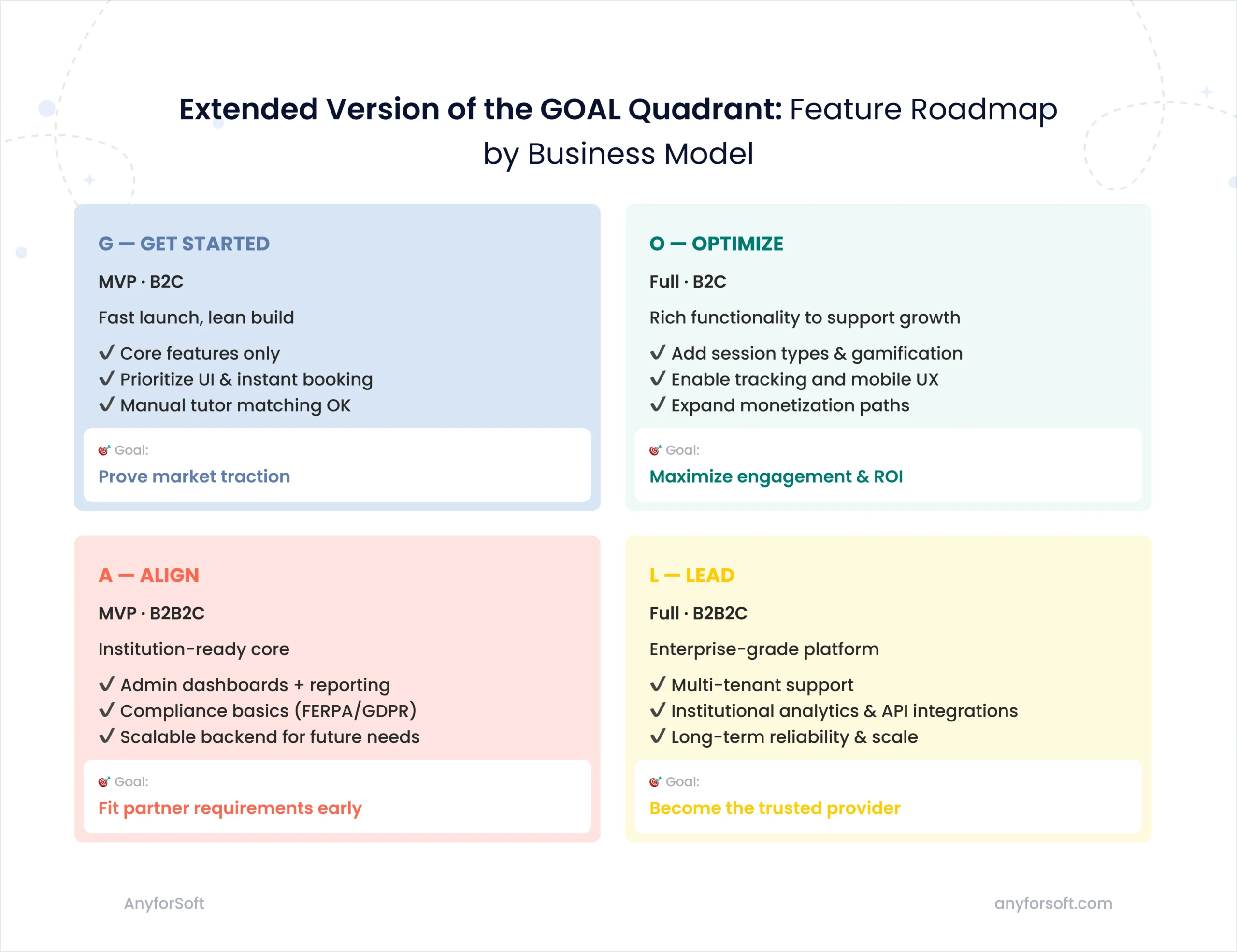
Why can’t you just “upgrade later”?
Starting with a B2C MVP and later converting it into a large-scale B2B2C solution seems a concise strategy if your goal is to start with a minimal budget while planning to scale later on. However, building software isn’t like adding floors to a beach hut. You can’t easily transform it into a skyscraper later.
B2B2C solutions demand foundational differences, including:
- Multi-tenant architecture.
- Institutional compliance.
- Integrations.
While pivots are technically possible, they’re often time-consuming and costly.
Defining Your Scope: Feature Matrix for Tutor App Development
While the Quadrant provides a strategic vision of the solution’s development, our ultimate point is a set of features — the “engines” that drive the entire application toward its core purpose for users.
Having a set of features from the start is rewarding. Consider two main reasons:
- You see the scope. Does the solution have three functional blocks or eight? Does each of them include two features or five? The number of functional blocks directly affects both the project cost and its timeline.
- You pitch with clarity. A solution with features outlined looks more tangible than a slide deck full of strategic goals.
If you come to a software development company with a general idea, that’s completely okay! However, having a clearer silhouette of the solution makes it much easier to align on expectations and proceed faster.
So, what features does your platform require based on your business model and scope?
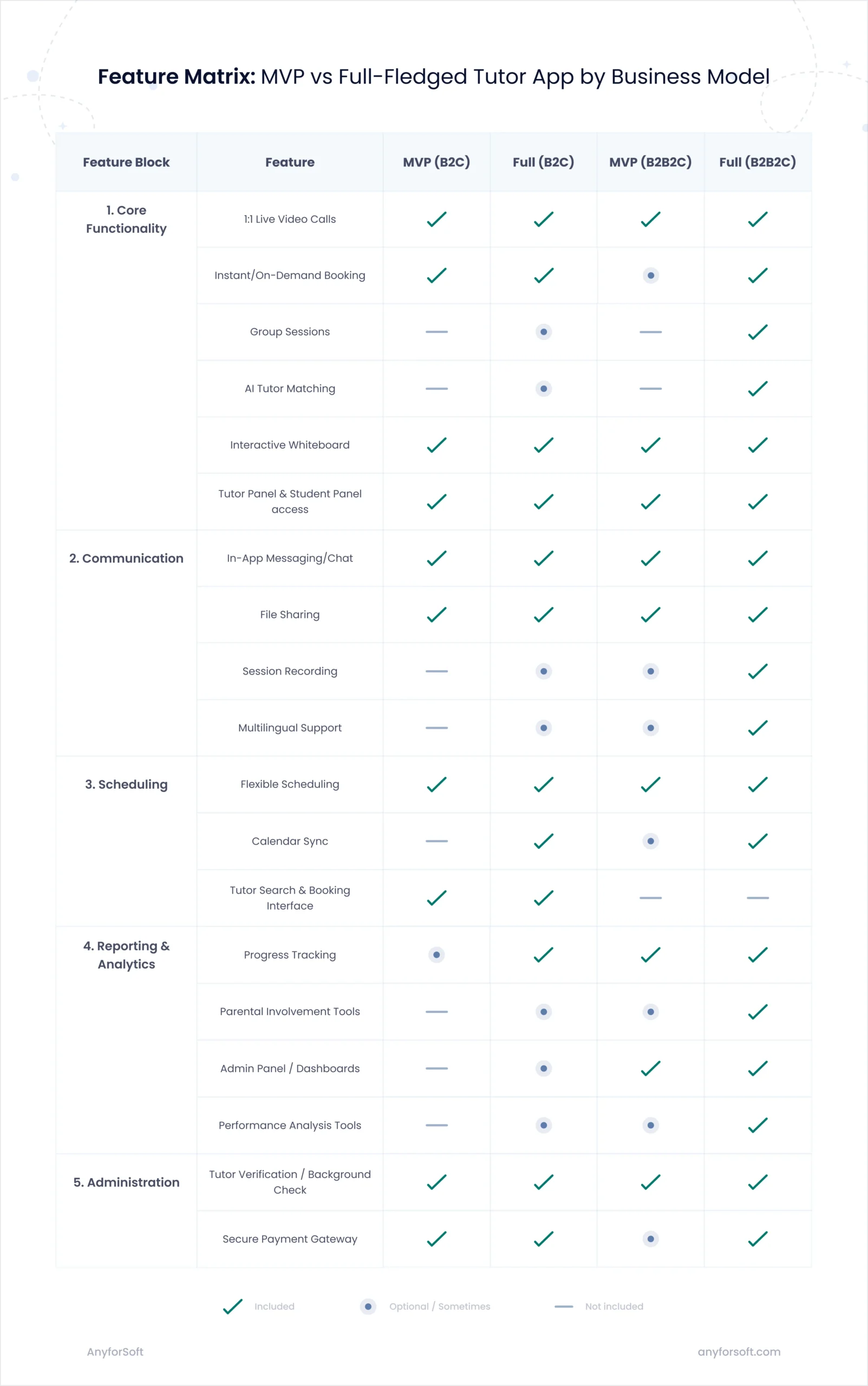
As you explore options, you might wonder: Do I really need certain advanced features at my stage?
AI solutions for education are especially attractive. In fact, 5 of the top 20 education apps in the U.S. App Store use AI for tutoring or assignment help.
However, whether to include AI (or any other advanced features) depends entirely on your business model and growth stage.
“We usually recommend adding AI only after the core tutoring workflows are stable and generating real user activity,” explains Oleg Bogut, CTO at AnyforSoft. “At the MVP stage, it’s more important to validate user flows and platform reliability. AI works best when it’s built on meaningful data. Naturally, that comes after you’ve launched, not before.”
Final Advice, Tailored to Your Tutor Booking App Development Journey
Creating an on-demand tutor app can mean different things to different people. That’s why, instead of closing with a one-size-fits-all summary, the AnyforSoft development team offers a set of final thoughts tailored to your role and context.
The goal is to support you through the full tutor app development journey with minimal cost and maximum clarity.
- For startup founders and product owners. Validate real user pain points before coding your first screen. What do your early adopters actually need on day one? A lean, well-targeted MVP often outperforms a bloated app with unclear value.
- For educational institutions and innovation teams. You want academic support that scales and aligns with your internal goals. Start with market research and define what success means for students, teachers, and admins. Prioritize features that help you monitor your platform and keep it running smoothly, such as user analytics, compliance tools, and LMS integration.
- For business leaders entering EdTech. You’re not just building a product. You’re stepping into a competitive learning ecosystem. Focus your investment on features that drive outcomes: faster matching, richer tutoring sessions, smarter data. Plan thoroughly from the start to avoid unnecessary rework later.
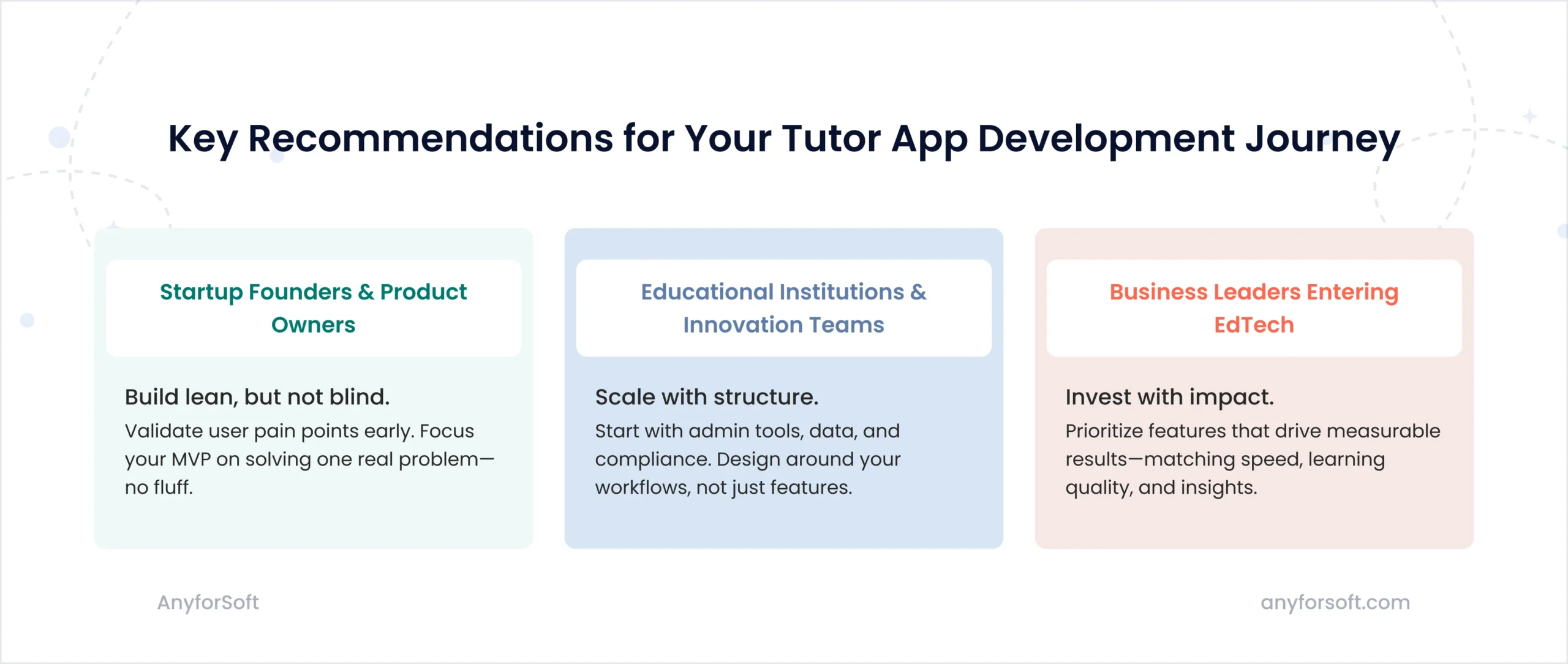
No matter where you start, we’re here to help turn your vision into a functional, scalable tutor app able to enhance learners’ educational outcomes.
FAQs
Absolutely. The AnyforSoft team has extensive experience creating educational platforms that blend powerful functionality, intuitive design, and seamless integrations. For example, we helped an education company fully modernize their e-learning platform by designing a new mobile-first interface, building an entirely new admin section for content and user management, and supporting interactive formats like quizzes and video lessons — all tailored to boost engagement and scalability.
Our team also supported Wittenborg University of Applied Sciences in the Netherlands, transforming their website into a mobile-friendly, high-performance platform that serves a diverse, global student community.
In addition, we’ve delivered secure, scalable solutions for institutions like Imperial College Business School and Delaware County Community College, ensuring robust user management and compliance.
Our clients on Clutch highlight our strategic mindset, technical excellence, and ability to translate complex needs into reliable, user-centered solutions.
We know how to build apps that feel simple to learners but are powerful and secure under the hood, from smooth video calls to advanced progress tracking and admin dashboards.
Costs vary a lot depending on your business model, desired features, and technical complexity. You can expect to invest anywhere from $50,000–$100,000 for an MVP that covers core functions. If you’re planning a full-scale platform with integrations, advanced analytics, and strong personalization, the cost can exceed $250,000.
The final budget also depends on design needs and scalability considerations.
Building a basic MVP takes around 3–6 months if you want to launch quickly and test your idea. Developing a full-featured platform can take from 9 to 18 months, especially if you include complex integrations and extensive testing phases.
Some founders choose to release in stages, focusing first on core learning experiences and then layering in analytics and personalization tools. It’s also smart to plan time for user feedback and iterative improvements.
Long-term success often hinges on patience and continuous enhancement.
The essentials matter most. Think real-time video calls, instant booking, tutor and student panels, secure payment integration, and progress tracking. Strong admin controls, robust user management, and compliance features make a huge difference, too. One more thing: keep it simple.
We treat data security as a top priority, building apps in line with FERPA, GDPR, and other strict standards.
Our approach includes secure authentication, strong encryption, and rigorous testing at every stage.
Additionally, we conduct regular audits and implement monitoring tools to stay ahead of potential vulnerabilities. Because regulations evolve, we keep our clients updated and support them in ongoing compliance.
Yes, and not just technical fixes. We offer ongoing support that covers updates, security improvements, and performance optimization.
Our team can also help you adapt features based on real user feedback and changing market needs, which is crucial for long-term growth. Think of AnyforSoft as your technical partner rather than just a vendor.
Of course. Starting with a basic version helps you test your core idea without huge upfront risk. As you understand user needs, you can gradually add new features and integrations, evolving into a full-scale platform. This phased approach also helps manage budgets more predictably. Start small, grow big.
On-demand tutor apps focus on immediate learning needs, offering real-time connections instead of future bookings. Unlike teaching marketplaces that prioritize profile browsing and advance scheduling, these apps let students get help right when they need it most. They’re designed to be fast, intuitive, and centered around instant value, not long sales funnels. This model requires careful UX and backend design to ensure reliability and speed.
We design architecture with scalability in mind from day one, using load balancing, caching, and optimized databases to support growing demand.
Rigorous performance testing ensures your app stays fast and reliable under heavy usage.
Additionally, we plan for future growth by implementing flexible, modular systems that can evolve as your audience expands.
Absolutely. Integrating your on-demand tutor app with an LMS or SIS can transform separate tools into one seamless learning environment. It’s not just about plugging in APIs; it’s about making sure data flows reliably, securely, and without disrupting the user journey.
When we design integrations, we focus on:
- Smooth data synchronization for grades, progress, and user accounts.
- Secure authentication and role-based access to protect sensitive information.
- Consistent UX so learners don’t feel like they’re jumping between systems.
This way, your platform feels unified and strong.
You have plenty of options, and it all depends on your business model.
If you go B2C (direct to students), you focus on individual payments and scaling user numbers. B2B2C, on the other hand, involves working with schools or organizations, aiming for stability and larger contracts.
Here’s a quick breakdown.
B2C (direct to learners):
- Pay-per-session (students pay for each lesson).
- Monthly or yearly subscriptions for unlimited or discounted access.
- In-app purchases (extra resources or exclusive content).
- Ads or sponsored content (if it fits your brand).
B2B2C (through institutions):
- Long-term institutional contracts (schools pay for access).
- Per-student licensing fees.
- Tiered service packages (basic vs. premium access for schools).
- Revenue sharing models with educational partners.
You can start simple and expand as your user base and brand grow. Flexibility is the ultimate key here. Choose what aligns best with your goals and audience.








